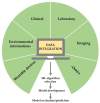Artificial Intelligence in Hypertension Management: An Ace up Your Sleeve
- PMID: 36826570
- PMCID: PMC9963880
- DOI: 10.3390/jcdd10020074
Artificial Intelligence in Hypertension Management: An Ace up Your Sleeve
Abstract
Arterial hypertension (AH) is a progressive issue that grows in importance with the increased average age of the world population. The potential role of artificial intelligence (AI) in its prevention and treatment is firmly recognized. Indeed, AI application allows personalized medicine and tailored treatment for each patient. Specifically, this article reviews the benefits of AI in AH management, pointing out diagnostic and therapeutic improvements without ignoring the limitations of this innovative scientific approach. Consequently, we conducted a detailed search on AI applications in AH: the articles (quantitative and qualitative) reviewed in this paper were obtained by searching journal databases such as PubMed and subject-specific professional websites, including Google Scholar. The search terms included artificial intelligence, artificial neural network, deep learning, machine learning, big data, arterial hypertension, blood pressure, blood pressure measurement, cardiovascular disease, and personalized medicine. Specifically, AI-based systems could help continuously monitor BP using wearable technologies; in particular, BP can be estimated from a photoplethysmograph (PPG) signal obtained from a smartphone or a smartwatch using DL. Furthermore, thanks to ML algorithms, it is possible to identify new hypertension genes for the early diagnosis of AH and the prevention of complications. Moreover, integrating AI with omics-based technologies will lead to the definition of the trajectory of the hypertensive patient and the use of the most appropriate drug. However, AI is not free from technical issues and biases, such as over/underfitting, the "black-box" nature of many ML algorithms, and patient data privacy. In conclusion, AI-based systems will change clinical practice for AH by identifying patient trajectories for new, personalized care plans and predicting patients' risks and necessary therapy adjustments due to changes in disease progression and/or therapy response.
Keywords: artificial intelligence; big data; blood pressure; deep learning; deep neural networks; digital health; hypertension; machine learning; photoplethysmograph; wearable technology.
Conflict of interest statement
The authors declare no conflict of interest.
Figures


References
-
- Visco V., Finelli R., Pascale A.V., Giannotti R., Fabbricatore D., Ragosa N., Ciccarelli M., Iaccarino G. Larger Blood Pressure Reduction by Fixed-Dose Compared to Free Dose Combination Therapy of ACE Inhibitor and Calcium Antagonist in Hypertensive Patients. Transl. Med. UniSa. 2017;16:17–23. - PMC - PubMed
-
- Whitworth J.A., World Health Organization. International Society of Hypertension Writing Group 2003 World Health Organization (WHO)/International Society of Hypertension (ISH) statement on management of hypertension. J. Hypertens. 2003;21:1983–1992. doi: 10.1097/00004872-200311000-00002. - DOI - PubMed
Publication types
LinkOut - more resources
Full Text Sources
Miscellaneous

